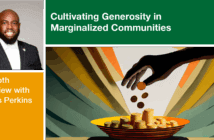Lewis Center Director F. Douglas Powe and Associate Director Ann A. Michel reiterate the importance of nine major trends they outlined last year. They also name five other emerging trends ranging from the rise of digital ministry to the waning influence of denominational institutions.
Last year, we named some of the major trends shaping the contours of congregational life. (See 9 Top Trends Impacting Church Leadership). These trends are:
- Changes in church attendance patterns including decreasing worship attendance across the theological spectrum and less frequent worship attendance among “regular attendees”
- Changing lifestyles, particularly delayed marriage among younger adults
- Growing income inequality and the disturbing tendency for lower-income families to be dechurched
- Demographic shifts and increasing cultural diversity that jeopardize the future of congregations unable to adapt to changes in their communities
- Changes in how people connect with congregations including the eroding paradigm of membership and the importance of entry points other than Sunday worship
- The imperative of reaching beyond church walls in an era when fewer and fewer people are culturally predisposed to finding their way to church on their own
- New more organic approaches to faith formation less dependent on traditional preaching and teaching
- Creative approaches to church financing to enhance economic sustainability in an era when tithes and offerings may no longer be enough
- Changes in the religious workforce such as an increase in part-time and bi-vocational clergy and more laity in significant ministry roles as paid staff or volunteers
We still see these nine overarching trends as dominant factors shaping the future direction of the church in this period of disruptive change. In the past year, however, several other trends have captured our attention. These changes are not wholly unrelated to the overall climate of change reflected in the trends outlined above. In fact, they appear to be consequences of these broader trends as congregations and other religious organization adapt to the evolving ecclesial and cultural milieu.
1. The move to the internet
The internet has revolutionized every aspect of our lives — how we engage commerce, entertainment, and education. For digital natives, the virtual realm is real. It’s where they meet people and form and sustain relationships. And cutting-edge church leaders understand that the church must also live on the internet in ways that go beyond online giving or streaming Sunday morning worship on Facebook Live for members who are home sick. From online Bible study groups that engage people across the street and around the globe to the formation of new faith communities that exist solely online and from worship services conducted exclusively for online audiences to the embrace of more savvy digital fundraising, we are just beginning to see how the internet has the potential to totally redefine how many people engage the Christian faith.
2. Decreased reliance on denominations
The influence and role of denominations in church life continues to wane. For several decades, it has been apparent that people give far less weight to denominational labels in choosing what church to attend. Denominational agencies are shrinking, and many church-related institutions are struggling as their resources and clout diminish. Because of shrinking congregational attendance there are fewer opportunities for full-time clergy. This translates into more clergy seeking nontraditional ministry opportunities often beyond the purview of denominational hierarchies. Today, even congregations firmly bound to their denominations are more likely to “go it on their own” when seeking educational and program resources, raising up and equipping leaders, and defining themselves on matters of theology, social policy, and practice.
3. New patterns of relating to property and physical location
Many congregations, particularly in high-priced real estate markets, leverage the value of their property through rentals or creative space sharing arrangements with mission partners or community groups. But some innovative congregations are going even further in redefining how they live in relation to their physical space. While owning a building has long been a defining characteristic of a mature congregation, we have seen examples of congregations burdened with debt selling their buildings and renting commercial space to free themselves of maintenance concerns and focus resources on mission. Some congregations house their staff in co-working spaces while other congregations are hosting co-working spaces for community members. And some new congregations are investing in mixed-use properties with income generating potential or partnering with commercial developers or retailers to acquire needed space. While these approaches are still the exception to the rule, they may be clues to future financial sustainability.
4. The emergence of new staffing patterns
One component of the changing nature of the religious workforce is an increase in paid staff. But it also seems there are notable changes in how churches deploy their staffs as a result of broader workplace trends and changing patterns of ministry. It is more typical today for lay staff to work in program areas like children’s ministry, youth, and music rather than just in administrative or support roles. Congregations increasingly look for staff with specific skills in communication, marketing, fundraising, and other needed specialties. The traditional role of church secretary is being reshaped, or in some cases replaced, due to advances in software and electronic communication. And newer approaches to religious education and Christian formation are less likely to rely on a full-time Christian educator, whether clergy or lay.
5. Changes in worship music
According to the National Congregations Study, the percentage of congregations incorporating choir singing into their worship fell from 54 percent in 1998 to 45 percent in 2012. While choirs are still strong in black Protestant and Catholic congregations, the downward trend was pronounced in white Protestant churches. In 2012, people in only about one third of white Protestant churches heard a choir sing at its most recent main worship service. Many factors could be at play — a trend toward more informality in worship, the rise in satellite services, aging voices, and fewer people willing to commit time to rehearsal. But another factor may be generational and cultural changes in how people experience and consume music. Scott Chrostek, pastor of Resurrection Downtown in Kansas City, says “If you stop to think about it, the church is the only place where people are invited to sing aloud to songs they do not know in front of total strangers.” He says many of his Millennial worshippers did not grow up with group singing as a regular staple of family and community events, as their parents and grandparents did.
There are, of course, a myriad of other forces at work in the changing landscape of congregational life. But these five trends rose to the surface in our work and research over the past year.
Related Resources
- Changes Congregations Face Adult Leadership Study Curriculum
- 9 Top Trends Impacting Church Leadership by Doug Powe and Ann A. Michel
- Discovering God’s Future for Your Church Video Tool Kit






